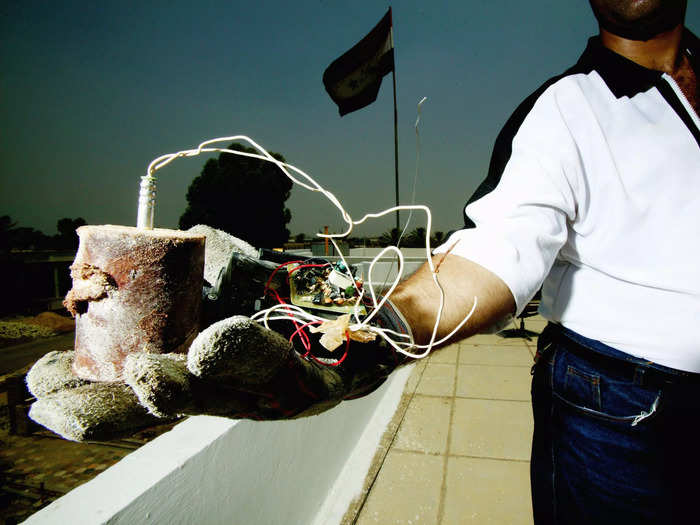
Thousands of improvised explosive devices, or IEDs, are still buried in Iraq after the war with ISIS.Meethak Al Khatib/Insider

The prominence of these improvised explosive devices around Iraq has meant that highly trained deminers are now going around searching for and dismantling thousands of IEDS.
"Our job has a saying that goes, "There's no room for mistakes to happen twice. Because the first mistake will be death," Falah Hassan, a reminder, told Insider.

Hassan told Insider that most of these IEDs were planted by ISIS in 2014. At their height, the militant group controlled as much as 40% of Iraq.
The majority of IEDs have been found in and around Mosul, which ISIS had once deemed its capitol.
"This was to prevent the [Iraqi] army from advancing during military operations and also to prevent civilians and residents from leaving the city of Mosul," Hassan said.

The team met at a base where local NGO groups that specialize in demining met before driving to the village of Abzakh, about 240 miles north of Baghdad.

Hassan told Insider that the equipment used in the search and stabilization efforts is "heavy," and affects workers' bodies.
But beyond that workers risk accidentally detonating the devices that are typically buried underground and can detonate by the slightest touch.
"IEDs can be detonated in three different ways. First, by a timer, and second, by an initiated order — by a wire or wirelessly using a phone. Third and last is by the victims themselves, either by pressure or movement," Hassan said.

IEDs typically have a detonator, a battery, a main charge, and a pressure plate that acts as a switch. While some may be covered in plastics, others are metal which could also turn into shrapnel is the device explodes.
"The digging process is very, very scary and very hard. It requires steadiness and self-confidence in order to do it," Hassan said.
Even if a device doesn't have an obvious switch, it's usually loaded with chemicals that make it just as likely to explode, or worse, the switch could be hidden.
IEDs have killed more than 50,000 people over the past 10 years.

Despite the risks, Hassan sees a lot of reward in his job, which sometimes includes disassembling 15 IEDs a day in the blazing heat of the Iraqi desert.
"I can see my achievements right away. But, if I were a teacher, I would have to wait an entire year to see the results of my teaching on the students. The energy I get here is linked to being a humanitarian," he told Insider.
 Saudi Arabia wants China to help fund its struggling $500 billion Neom megaproject. Investors may not be too excited.
Saudi Arabia wants China to help fund its struggling $500 billion Neom megaproject. Investors may not be too excited. I spent $2,000 for 7 nights in a 179-square-foot room on one of the world's largest cruise ships. Take a look inside my cabin.
I spent $2,000 for 7 nights in a 179-square-foot room on one of the world's largest cruise ships. Take a look inside my cabin. One of the world's only 5-star airlines seems to be considering asking business-class passengers to bring their own cutlery
One of the world's only 5-star airlines seems to be considering asking business-class passengers to bring their own cutlery Experts warn of rising temperatures in Bengaluru as Phase 2 of Lok Sabha elections draws near
Experts warn of rising temperatures in Bengaluru as Phase 2 of Lok Sabha elections draws near
 Axis Bank posts net profit of ₹7,129 cr in March quarter
Axis Bank posts net profit of ₹7,129 cr in March quarter
 7 Best tourist places to visit in Rishikesh in 2024
7 Best tourist places to visit in Rishikesh in 2024

Copyright © 2024. Times Internet Limited. All rights reserved.For reprint rights. Times Syndication Service.